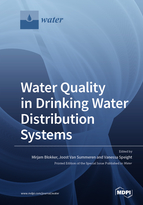Water Quality in Drinking Water Distribution Systems
A special issue of Water (ISSN 2073-4441). This special issue belongs to the section "Water and One Health".
Deadline for manuscript submissions: closed (31 January 2020) | Viewed by 41818
Special Issue Editors
Interests: water quality; drinking water distribution systems; drinking water demand; discoloration; self-cleaning networks; network design; water age; QMRA; biofilm
Interests: water quality; drinking water distribution systems: discoloration; sensor placement; soft sensors; experimental setup design
Special Issue Information
Dear Colleagues,
Safe drinking water is paramount for the health and wellbeing of all populations. Water is extracted from surface and groundwater sources and treated to comply with drinking water standards. The water is then circulated through the drinking water distribution system (DWDS). During travel within the DWDS, water quality can deteriorate due to microbiological growth, chemical reactions, interactions with ageing and deteriorating infrastructure, and through maintenance and repair activities. Some DWDS actions may serve to improve water quality, however, these can also adversely impact the drinking water system and cause instances of poor water quality or disease outbreaks.
We invite papers to examine DWDS design and operational practices and their impact on water quality. A wide range of water quality aspects are of interest, such as discoloration, water age, chlorination, biofilm, (fecal) contamination, etc. We welcome papers based on practical research in real DWDS and lab test facilities. We also welcome papers on novel modeling approaches.
Dr. Mirjam Blokker
Dr. Joost van Summeren
Dr. Vanessa Speight
Guest Editors
Manuscript Submission Information
Manuscripts should be submitted online at www.mdpi.com by registering and logging in to this website. Once you are registered, click here to go to the submission form. Manuscripts can be submitted until the deadline. All submissions that pass pre-check are peer-reviewed. Accepted papers will be published continuously in the journal (as soon as accepted) and will be listed together on the special issue website. Research articles, review articles as well as short communications are invited. For planned papers, a title and short abstract (about 100 words) can be sent to the Editorial Office for announcement on this website.
Submitted manuscripts should not have been published previously, nor be under consideration for publication elsewhere (except conference proceedings papers). All manuscripts are thoroughly refereed through a single-blind peer-review process. A guide for authors and other relevant information for submission of manuscripts is available on the Instructions for Authors page. Water is an international peer-reviewed open access semimonthly journal published by MDPI.
Please visit the Instructions for Authors page before submitting a manuscript. The Article Processing Charge (APC) for publication in this open access journal is 2600 CHF (Swiss Francs). Submitted papers should be well formatted and use good English. Authors may use MDPI's English editing service prior to publication or during author revisions.
Keywords
- Water quality
- Drinking Water Distribution Systems
- chlorination
- discoloration
- infection risk
- biofilm
- contamination
- water age
- cleaning








